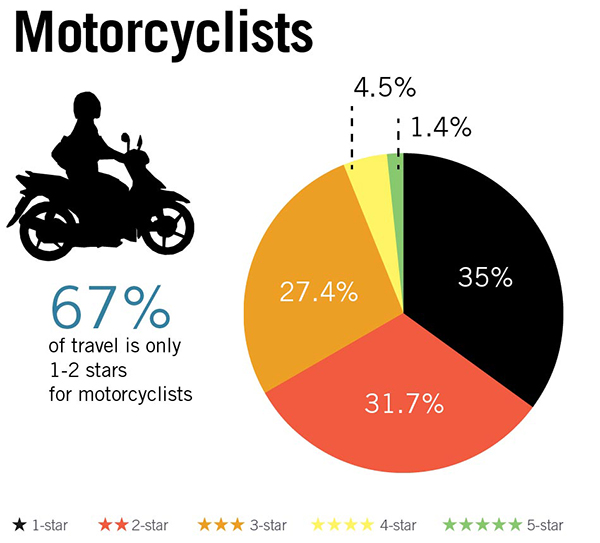





Lane Change
Lane change crashes occur when one vehicle attempts to change lanes and collides with another vehicle travelling in the same direction. This crash type is most common on higher volume multi-lane roads (such as motorways and urban arterial roads).
These crashes are common where traffic merges or diverges and where the number of lanes is reduced.
It is also common where there is roadside activity (such as roadside markets or locations where public transport vehicles pick up and drop off passengers).
The severity of the collision between the vehicles of common size is often low, due to low relative speeds. However, if vehicles or road users of different size collide, the consequences can be very severe (e.g. motorcyclist and car, car and truck).
Typical factors which may add to lane change crash risk include:
- Inappropriate speeds.
- Poor pavement skid resistance.
- Unexpected or poor lane drop-offs or merge areas.
- Inadequate length for merging or weaving.
- Roadside activity.
- Poor directional signs or lane markings.
- Poor visibility including ‘blind spots’ and at merging areas and towards diverging areas.
- Driver/rider fatigue.
- Alcohol/drugs/medication impairment.
- Distraction, including inattention due to mobile phone use.
- Information overload (too many driving decisions to be made at once).
- Lack of familiarity with the route.
- Lack of vehicle safety devices.
- Poor condition of vehicle tyres, lights, and brakes.
Case Studies
| Name | Cost rating | Effectiveness |
|---|---|---|
| Central Turning Lane Full Length | Low | 10 – 25% |
| Delineation | Low | 10 – 25% |
| Intersection – Delineation | Low | 10 – 25% |
| Intersection – Grade Separation | High | 25 – 40% |
| Intersection – Turn Lanes (Signalised) | Low to Medium | 10 – 25% |
| Intersection – Turn Lanes (Unsignalised) | Low to Medium | 10 – 25% |
| Motorcycle Lanes | Medium | 25 – 40% |
| Parking Improvements | Low to Medium | 10 – 25% |
| Regulate Roadside Commercial Activity | Low to Medium | 10 – 25% |
| Speed Management | Medium | 25 – 40% |
| Traffic Calming | Medium to High | 25 – 40% |
| Name | Cost rating | Effectiveness |
|---|---|---|
| Motor Vehicle Standards | – | – |
| New Car Assessment Program (NCAP) | – | – |
| Used Car Safety Ratings | – | – |
| Safety Features and Devices | – | – |
| Vehicle Roadworthiness | – | – |
| Name | Cost rating | Effectiveness |
|---|---|---|
| Addressing Alcohol and Other Drugs | – | – |
| Education | – | – |
| Enforcement | – | – |
| Fatigue Management | – | – |
| Helmets and Protective Clothing | – | – |
| Licensing | – | – |
| Publicity | – | – |
| Safe Speed | – | – |
| Seatbelts | – | – |
 A motorcycle crash. Image credit: iStock
A motorcycle crash. Image credit: iStock Motorcyclist Star Ratings by road user type based on a 358,000km sample of roads across 54 countries. Image credit: iRAP
Motorcyclist Star Ratings by road user type based on a 358,000km sample of roads across 54 countries. Image credit: iRAP Vehicle occupant Star Ratings by road user type based on a 358,000km sample of roads across 54 countries. Image credit: iRAP
Vehicle occupant Star Ratings by road user type based on a 358,000km sample of roads across 54 countries. Image credit: iRAP Lane change left
Lane change left Side swipe crash in Singapore. Image credit: Alina Burlacu
Side swipe crash in Singapore. Image credit: Alina Burlacu








